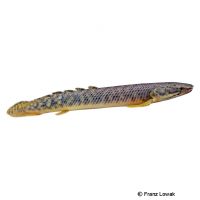Shortfin Bichir (Polypterus palmas)
| Shortfin Bichir Polypterus palmas | |
|---|---|
| Name | Shortfin Bichir |
| Name Lat. | Polypterus palmas |
| Family | Bichirs |
| Family lat. | Polypteridae |
| Order | Bichirs |
| Order lat. | Polypteriformes |
| Origin | West Africa |
| Habitat | Rivers |
| Diet | Carnivore |
| pH | 6.0-7.0 |
| Behavior | Nocturnal, predatory |
| Keeping | Individual, pair |
| Care Level | Moderate |
| Reproduction | Egg scatterer |
| Breeding | Difficult |
| Life Span | 8-10 years |
| Protection | No |
| Metric Units | |
| Size | 20-25 cm |
| Temperature | 24-28 °C |
| Hardness | 5-15 °dH |
| Aquarium | 250 l |
| US Units | |
| Size | 8"-10" |
| Temperature | 75-82 °F |
| Hardness | 89-267 ppm |
| Aquarium | 65 gal |
Distribution and habitat
Palmas shovelnose pike are widely distributed in western Africa from Senegal and Liberia to Ivory Coast and Congo, where they live in pools, swamps, rivers, lakes, and freshwater lagoons. They are crepuscular and nocturnal predators that like to spend time in weedy riparian waters with numerous hiding places.
Maintenance
The aquarium should have dense planting, with plenty of hiding and retreat opportunities (roots, stones, caves). A soft substrate, slightly acidic water and subdued light (floating plant cover) is ideal. Due to their way of life they need only little swimming space.
No ammonia, ammonium and nitrite should be detectable, the nitrate value should not exceed 100 mg/l. To ensure the water quality and oxygen content, a filter and heater adapted to the aquarium size is required, as well as lighting for the species-appropriate day-night rhythm of the animals.
Diet
According to their size, the food offer consists of live food, such as tubifex, black mosquito larvae, shrimps, earthworms, meal beetle larvae and crayfish, which is also accepted in frozen form, supplemented with commercially available frozen special food mixtures. Rarely, high-quality protein-rich dry food (pellets) is also accepted. Due to their visual impairment, finding food is done with the sense of smell.
Only as much should be fed as is eaten overnight. A regular and varied diet promotes health and prevents deficiency symptoms.
Behaviour and compatibility
They are territorial and sometimes incompatible with each other, so keeping several animals is only possible in a much larger and richly structured tank. Towards other fish they behave peacefully and can be socialized well with cichlids and catfishes of suitable size. Fish that are too small are considered food
Basically, only compatible fish species with similar demands on water condition and water temperature may be socialized.
Sex dimorphism
Males have a larger and thicker anal fin, which also serves as a mating organ.
Reproduction and breeding
There are no known confirmed reports of successful breeding in the aquarium. It is assumed that reproduction occurs as in other Polypterus. The eggs are taken over by the male for insemination during courtship and scattered over the plant thicket. After about 4 days, the fry hatch and swim free after another 3 days. The parents are spawn predators
The fry must be fed several times a day with special rearing food (artemia euplii, microworms). It is recommended to raise the fry individually, otherwise they will eat each other. In community tanks breeding is hardly possible, because the spawn is easy prey.
Important
Their swim bladder is divided into two parts, with the larger right part serving as an additional respiratory organ. This allows them to survive for some time out of the water in humid environments. They have to go to the water surface at intervals to breathe atmospheric air, as their gill breathing is not sufficient. If they are prevented from doing so, they will suffocate. Care should be taken to provide good aquarium cover (spring protection), as there is a risk of escape, especially during the nocturnal periods of activity. They may lean on their ventrals to rest.
The well-being of the fish should be checked regularly. Temperature should be checked daily, pH, hardness and nitrate levels at least fortnightly. Regular partial water changes are recommended, even if the contaminant level has not yet reached the upper limit. Sudden changes in water quality should be avoided. Newly introduced fish must be accustomed slowly to the water in the aquarium.
Further literature can be found in your pet store.
References
Text: petdata; Image: Franz Lowak
Source: BMELV (1998): Tierschutzgutachten - Haltung von Zierfischen (Süßwasser); BAENSCH & RIEHL (2004): Aquarien Atlas Bd. 2, Mergus Verlag; ENGELMANN (2005): Zootierhaltung - Tiere in menschlicher Obhut: Fische, Verlag Harri Deutsch
- Gemäß § 21 Abs. 5 Tierschutzgesetz idgF
